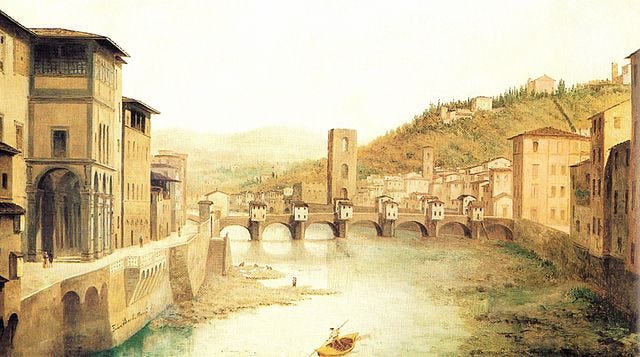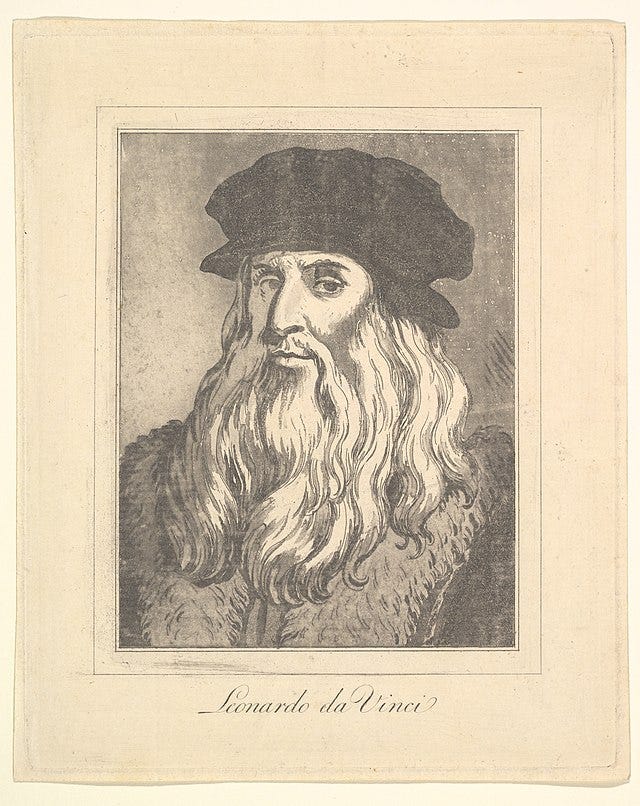Before we get into today’s article, I wanted to let you know about a series I’m releasing beginning this Friday that will feature a new original work of mine debuting at the end of each week. From unreleased songs and poems to my band’s latest recorded single, you’ll get a new, exclusive original piece delivered to your inbox each Friday over the next few weeks. I love writing about classical culture, but I want to also show how these works deeply influence my own contemporary creations. I’m excited to share them with you! Now onto today’s article. Let’s take a walk down historic roads…
“Beautiful Florence has all seven of the fundamental things a city requires for perfection…” -Benedetto Dei, essayist


I’m currently making my way through one of the best biographies I’ve ever read. It’s about an artistic figure who’s inspired me most of my life, Leonardo da Vinci. As long as I can remember, I’d stare at one of his prints my parents had hanging in their home (it now proudly hangs in mine), and I’d marvel at his Vitruvian Man, Last Supper, and Mona Lisa.
I highly recommend Leonardo da Vinci by Walter Isaacson (book review coming soon on CC!). Not only does the non-fiction work offer an eye-opening look into the artist and science buff’s most intimate journal entries and sketches of invention, but he paints such a vivid picture of Early Renaissance Florence, you feel like you’re walking the artisan-lined streets along with the author as you make your way through the book. He acts as a wonderful tour guide.
One of the passages stood out to me the other day. Isaacson mentioned Benedetto Dei, a writer who in 1472 praised the bustling city of Florence. In one of his essays he referenced the city’s seven pillars that acted as a solid foundation for its flourishing culture. The seven fundamentals he listed are striking, and just as applicable today.
During these contemporary times, when culture and etiquette seem to be lost arts, taking Dei’s message to heart and striving to be examples of flourishing individuals is paramount for giving rise to a modern culture built on virtuous principles, civility, and last but not least, incredibly inspiring art.
Dei’s Observations
Liberty
Dei noted that citizens of Florence enjoyed “complete” liberty. His observations were pretty spot on, especially for the times. The Renaissance period was a time of great enlightenment towards the individual. Because of this humanist philosophy, people enjoyed a grand amount of freedom like never before. While ancient forms of liberty saw man as a free agent by the hand of his respective city-state’s government, many cities in Italy recognized autonomy, man’s individual rights, and a republican process of election as vital to the success of society as a whole.
Etiquette-driven Population
Early Renaissance Florence housed a proud population and Dei was pleasantly surprised at the emphasis citizens put on appearance while out in public. Describing everyone as “elegantly dressed,” it seems that being surrounded by beautiful art and grand architecture extended to wardrobes. It’s no wonder Italy today is considered to be a fashion mecca (the country is shaped like a boot after all). But even as far back as the 1400s, the townspeople looked to their outfits as extensions of their own personal artistic philosophies.
Even da Vinci himself was known for donning intricately detailed, brightly colored outerwear. And when he was still in his early twenties, one of Leonardo’s mentors was so struck by his beauty he’d often use the budding artist as a human prop while sketching.
Clean Water and Industrious Makeup
Situated along a river with “clear, pure water,” Florence not only maintained a near-pristine appearance, especially with respect to its natural elements, it also sported an industrious sector. Several mills could be found “within its walls,” and the city was full of “entrepreneurial silk weavers.” These skilled workers were part of its booming textile economy which supplied “wool and silk fabrics for luxury markets.”
A healthy environment and robust industrialization are often seen as polar opposites. But the people of Florence expertly oversaw both natural and manmade structures. And their due diligence helped these opposing forces coexist successfully in tandem.
Strong Civic Leaders and Government
The Florentine government oversaw a significant amount of territory. According to Dei, it ruled over “castles, towns, lands, and people.” While this may seem daunting to the modern day philosopher, land and territory ownership was crucial to a city’s survival. And its interaction with neighboring towns could make or break its independence. While Ancient Greece found its city-states vulnerable to attack from neighboring territories either due to their own aggression (Sparta) or a lack of formal defense, Italian cities learned from their predecessors’ mistakes and formed a more sound hierarchical governmental structure.
Unlike other places in Italy, Florence was not ruled by royalty. And most importantly, it strove to maintain peaceful relations with its neighbors.
Unique Educational Opportunities
“Its leading thinkers embraced a Renaissance Humanism that put its faith in the dignity of the individual and in the aspiration to find happiness on this earth through knowledge.” -Isaacson
The Italian Renaissance bestowed upon humanity a wealth of knowledge. Learning and applying skills to craft and trade was a vital, core part of Florence’s flourishing community. Studios and shops lined streets and artisans banded together with goldsmiths and scientific pioneers to produce some of history’s most cherished works. This collaborative way of looking at trade and craft produced a “stimulating environment for creativity.”
Because of this emphasis on both art and business, the city boasted a highly regarded university. The educational institution offered classes on Italy’s main influence during the Renaissance era, Ancient Greece. And it taught business classes geared towards accounting.
Masters of Craft
Florence in the 1400s was a bustling metropolis. And its growing population centered around highly skilled craftsmen and tradesmen. Among actively working Florentines “there were eighty-four wood-carvers, eighty-three silk workers, thirty master painters, and forty-four goldsmiths and jewelry craftsmen.” (Isaacson)
Business and Trade Oriented
Not only were Florentines entrepreneurially spirited, the early birthings of contract law, a type of law so important to business and trade, can be traced back to the booming city.
Notaries were everywhere, ready to sign off on official documents of all kinds.
One of the often overlooked pillars of business is the strength of the currency it accepts as payment. In Florence it was the “florin,” a gold coin touted for its purity that offered reliable currency for consumers and producers exchanging goods with it.
Florence’s strong economy and sound currency made it a “center of banking.” This mecca of commerce produced a strong middle class, a key component to history’s most prosperous societies.
Upholding Classic Principles
These seven fundamental keys to a flourishing society didn’t just work for Florence. They’ve worked for many thriving cultures throughout the world over many centuries.
What can we take from this list and immediately apply to our lives? Do we make our wardrobe an extension of our philosophy? Do we apply artistic Renaissance principles to our craft and reignite a passion for classic tastes? Do we strive for civility and cooperation among our fellow citizens as we run errands and work with others at our jobs?
Influencing a cultural rebirth seems like an impossible task, especially given today’s unpredictable and restless times. But we don’t inspire civil excellence by commanding others to follow rules. We inspire excellence by embodying time-honored, unbreakable principles. And if others attempt to destroy those principles, that’s when we hold fast to them and embody them ever more fervently.



